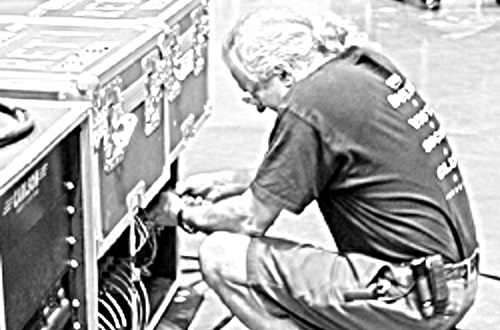We’ve all been there. Working a show or even attending as a spectator, the house system looks more than adequate but it under-performs. There are many reasons it happens, including broken components, lousy musicians, poor acoustics, operator error, and more.
Finding out if something is wrong with a system or individual components usually takes very little test equipment.
The first and most important tool is our ears. Listen to an installed system when it’s not in use or set up the PA at the shop to check it out. Hook up everything as always then play some known test tracks and really listen.
A friend mixes at a church for the teen praise band. The system is 4-way, portable, purchased used from a local DJ. My friend regularly complained that the mains didn’t quite sound right but never took the time to analyze it. One day I visited and helped him set up the system. We plugged it together, fired it up, and realized pretty quickly that all of the 6-inch midrange drivers weren’t working.
The problem? The system was wired as a 3-way rig with an amplifier for the subs, another amp for the lows, and what he had assumed was an amp for the mids and highs. Opening up a loudspeaker showed the mids were wired to the other Speakon connector on the back of the cabinet, so there was no amp (or crossover) feeding them. The previous owners had either used a different amp rack/wiring scheme, or never used the mids. Simply taking the time to listen led to the discovery of the problem.
Multiple Transgressions
Back when my company had a repair bench and did warranty work, one customer brought in a bunch of floor monitors and said all of the HF drivers had blown within a few weeks after buying them. After opening up the cabinets it appeared that the light bulb fuses to protect those drivers had been dislodged and/or fallen out of their holding clips. From the battered look of the monitors, it was quite apparent that they’d been tossed around so much in a short time that it had impacted the fuses.
Over the years I’ve seen cracked plastic, fiberglass and even metal horns, shifted transducer magnets, and all sorts of physical damage to components that were not all visible from the outside. Blown drivers probably top the list. As a result, every component in a system should regularly get a preventative maintenance check to make sure everything is working properly and to look for signs of misuse.
A common but often missed item is an incorrectly wired component or cable. This can wreak havoc where a driver or entire loudspeaker box is out of polarity with the rest of the system. As we all know (right?), if two signals are at the same frequency but one signal is reversed in polarity, those signals can cancel each other out.
Cables are easy to check with a standard cable tester. Drivers in the loudspeaker are a little more tricky unless you open up the box and trace the conductors from the connections to any internal crossovers and then to the drivers. One way to easily check gear is to employ a polarity test unit. I’ve been using a Cricket CPTS from Galaxy Audio for years to test polarity of loudspeakers, microphones, cables, signal processors and even mixers. The Cricket has a sending unit and a receiving unit and even works down a long snake or through house wiring.
In addition to reversed polarity issues, cable testers can also find miswired and broken cable connections. The CBT-500 multi-unit tester from Hosa Technology and the HCT-BD tester from RapcoHorizon are both staples of my toolkit, but there are many other good models on the market. My testers also accept a cable with different connectors on each end, which is very handy for checking adapter cables.
















